![]()
Nowhere is there a happier hunting ground for coaches than at the annual North-South All-Star game
Published in Sport Magazine, January 1954, pp. 42-45, 58-59
![]()
by EDD KELLOW
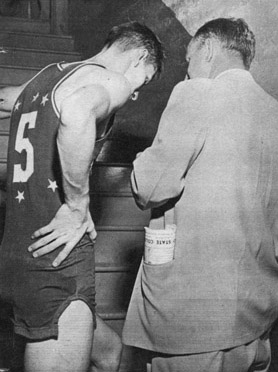 | High school players at Murray State all-star game listened to the sales talks of all college coaches. Only a few were "sold." |
Probably the largest and most successful of the scholastic all-star games in basketball is the North-South classic, played every year on the second Saturday in June at Murray State College in Kentucky. Twenty-four of the nation's best high school basketball players are up for grabs and a host of college coaches and athletic directors travel in for the auction.
For an entire week the small town of Murray is flooded with tall youngsters and sharp-eyed college coaches. Prior to the big game there are fish fries, barbecues, dances, parties, civic luncheons, movies - and practices. Two workouts every day and a constant flow of coaching pep talks build the rivalry between the two teams to a bubbling fever pitch that, on Saturday night, bursts into a battle resembling the original War Between the States. A good time is always had by all.
In the five years that the North-South game has been played, more high school stars have participated than in any other all-star game. The big attraction to the high school players is that an appearance in the game almost assures them a basketball scholarship at a major school. Altogether, 116 players have played in the five games and more than 100 of them received scholarships. The others were called into military service before they could start their college careers.
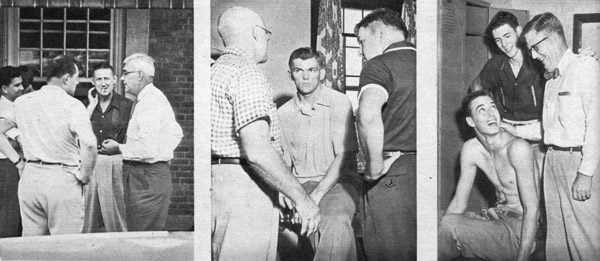 | Coaches at work: At left, Branch McCracken (Indiana), Hank Iba (Oklahoma A&M). Center, Dave Tschimperle says he chose Hamline because it is in the Minneapolis Laker area. At right, Jerry Mallet (seated) talks with Baylor coach. Later he went to Baylor. |
The alumni list of the annual game is equally impressive. Notre Dame alone lists six players from the first four years of the competition - Rich Rosenthal, Bill Sullivan, John Fannon, Bill Weiman, Lloyd Aubrey and Pete Faridoni. The University of Louisville has done almost as well with five alumni - Phil Rollins, Vlad Gastevich, Chuck Noble, Bill Powell and Bob Peterson.
Many other familiar college basketball names received a big boost to stardom in a North-South uniform. There has been Tom Gola (La Salle), Bob Pettit (LSU), Dick Knostman (Kansas State), Tom Marshall (Western Kentucky), B. H. Born (Kansas), Ken McCally (Navy), Howie Crittenden (Murray State), Chuck Mencel (Minnesota), Togo Palazzi (Holy Cross), Joe Richey and Hal Christensen (Brigham Young), Ed Conlin (Fordham), George Nordhaus (Vanderbilt), Gerald Stockton (Oklahoma A & M), and Clay Gray (California). Even the highly-publicized Bevo Francis saw action in a North-South game. Bevo didn't score 50 points, as was his habit at Rio Grande College last season, but he did hang up 13 during the 1952 game to help the North to an 84-70 win.
Practically every major basketball school has a representative at Murray during North-South week to scout the boys. Most college coaches come to town a week early to watch the team practices and talk with the players. The other coaches arrive for only the hectic weekend. Some coaches, with an uneasy eye cast in the direction of the NCAA, pass up a personal appearance at the game and, instead, send an assistant coach or trainer or loyal alumnus to look ťover the field. One way or another, they all get reports on individual players.
Such precaution has a solidly-established precedent. When the North-South game was inaugurated, many coaches, in their enthusiasm over the bountiful talent on the hoof and their unbridled bidding for a share of the teen-age loot, turned the game into a basketball slave market. All the kids were engulfed by fabulous offers and the more promising youngsters, at least, were going to the highest bidders. Such wholesale bartering soon came to the attention of the NCAA. The crackdown that followed caused the coaches to be a little more prudent in their salesmanship.
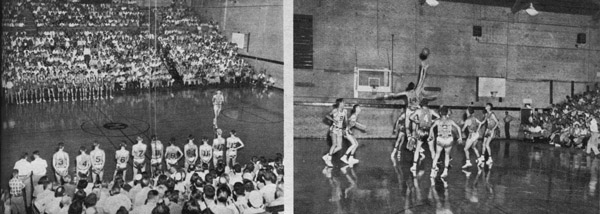 | The tiny (2,000) Murray State gym is always packed for the game. Even the June heat in Kentucky doesn't keep the crowds away. At opening center jump (right) 7'2" Gary Nelson (now at Washington) out-jumped 7' Charley Tyra to give North first basket. |
But they still get around. One way or another, the coaches manage to get their bids across to the boys. When the players aren't practicing, and their parents arrive in town for the game, the coaches throw lavish dinners and parties for families, friends and any other interested parties with some influence over the athletic juveniles.
One of the older coaches, who has made the trip to Murray all five years but has never shown any appreciable talent gain from it, explained that his visits are predicated on self-survival. "I'm only trying to protect and keep the player who has already agreed to go to my school," he said. "Most of these kids are subjected to so much pressure from all sides that I have to be here to keep the pressure from injuring the boy who is going to my school in the fall."
Not all the coaches have even this lofty a motive for their journey to Murray State. Nor is their selling job as easily accomplished as in past years. The youngsters, for the most part, have made up their minds where they are going by the time they get to Kentucky. They display a strong sales resistance to the high-pressure campaign they are submitted to, undoubtedly bolstered by the effective instruction and advice of the guiding fathers of their future alma maters.
However, a few still do change their minds after the glorious Murray fete. Jerry Mallett came to the last all-star game with a firm leaning toward the University of Texas. He occasionally talked that week with Baylor coach Bill Henderson and is now a freshman at Baylor. Hiles Stout, pledged to Bradley originally, switched to Illinois after his Murray excursion. Jim Ashmore was planning to attend Co-Lin College but finally registered at Mississippi State. Other A. M. (After Murray) transfers were Jimmy Peck, who theught he was going to Oklahoma A & M but ended up at Oklahoma; Bobby Powers, who is playing ball at Houston, after stating a preference for Michigan or Murray State; and Joe Todd, who announced his intention of going to Murray State when he arrived and was pledged to St. Louis by the time he left.
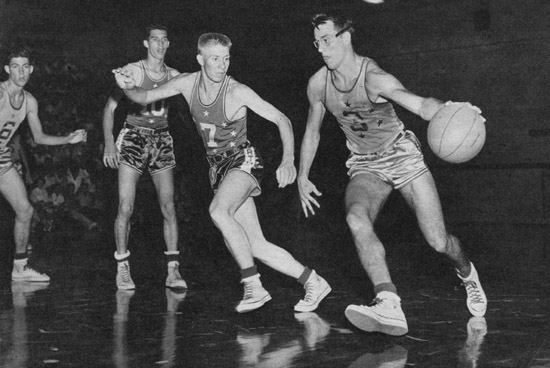 | Earl Adkins (with ball) was named game's outstanding player, is now at Kentucky. He was only married man on this year's roster. |
Although host school Murray State fared poorly with two of the above candidates, it did land Jimmy Mitchell, who did not change his mind. In fact, 18 boys held fast to their original choices and couldn't be switched. Seven-foot, two-inch Gary Nelson, one of the most badgered prospects, went, as he intended all along, to Washington U. Gene Elstun went to Kansas, John Murret (St. Louis), Henry Sullivan (Boston College), David Tschimperle (Hamline), Jim Krebs (Southern Methodist), Bill Altenberger (Illinois), Harvard Schmidt (Illinois), Cliff Hafer (North Carolina State), Dave Tucker (Minnesota), Ed Franklin (Baylor), Earl Adkins (Kentucky), Charles Tyra (Louisville), John Weissman (Villanova), Gary Thompson (Iowa State), Mickey Barnes (Baldwin College) and Roy Nissen (Iowa Teachers).
With every member of the 1953 squads landing a basketball scholarship, it's no wonder thousands of high school seniors try to get to the all-star game. Over 500 of them are nominated each year, by sportswriters throughout the nation. From the applications the nominees submit, a local committee weeds the list down to manageable size. Efforts are usually made to see that every section of the country is represented, but talent is not sacrificed in order to make the game national in scope - although 38 states have sent players to the affair.
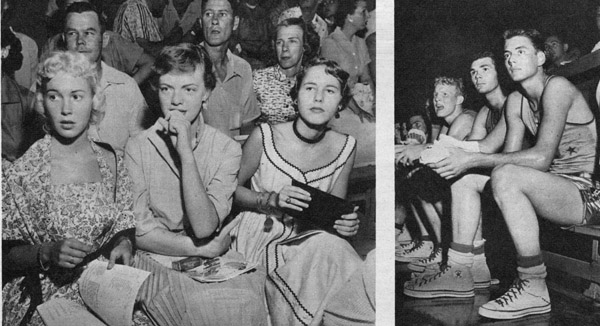 | (Left) Friends and relatives always travel to the big game. Here, girl friends of Jim Krebs (now at SMU) show anxiety as South falls behind in first half. (Right) In what is a hot rivalry, South bench follows action. Every boy got to play in the game. |
Originally, Murray State basketball coach Harlan Hodges wanted only to include an unambitious little all-star game with a coaching school sponsored by the college every spring. Hodges figured that such a game might help him get more and better playing talent for Murray State. His idea was to have a coach from the Chicago area come down with a group of Illinois high school stars while he himself provided a team of local Kentucky schoolboy talent. Before he could get his plans moving, however, Hodges was persuaded to make the game nationwide and include all states instead of just two. The plan, as such, was turned over to the Murray Chamber of Commerce, and Hodges stepped into the background.
"I can't take the responsibility of choosing players for the game without getting a lot of kids sore at me - and possibly losing boys I want badly," Hodges explained. "I'd like to have all these kids, of course, but I'm not going to try to persuade a boy to change his mind if he has already decided on a school." Hodges' game idea caught on fast and now the North-South game has dwarfed the coaching school so much that the clinic was recently dropped.
In its present state, the all-star game venture could be expected to cost more than $20,000. But almost nothing about this game is normal. The Murray State gym, which seats just over 2,000 paying customers, brings in only $4,000 (tickets sell for $2). Where the the rest of the money comes from lies in the ingenuity of the North-South Commission, a non-profit organization of Murray citizens which officially sponsors the game. More than $4,000 in profits is recorded annually from the sale of advertising space in a handsome 60-page souvenir program. The ads take up less than 50 per cent of the space in the journal, and rates are high, but Murray (and Kentucky) people who buy advertising space don't kick. They realize it is necessary to keep the game going. Then, too, advertisers get the choice seats. This has proved over the years to be a strong inducement. With so few seats available, tickets to the game are always at a premium.
Room and board for the players costs the commission nothing as dormitories are made available and meals are served in the college cafeteria. (This same courtesy is extended to the coaches.) Equipment for the game would cost over $1,200 if purchased at wholesale prices. The uniforms and all other equipment - along with jackets, miniature gold basketballs and other souvenirs - are given to the players after the game. And yet, for all of this, the commission spends less than $600. A sporting goods company which handles about 90 percent of the college's athletic orders has made it possible for nationally-known companies to provide their products for the game. A major shoe company even sponsors the selection of the official "high school All-America" team.
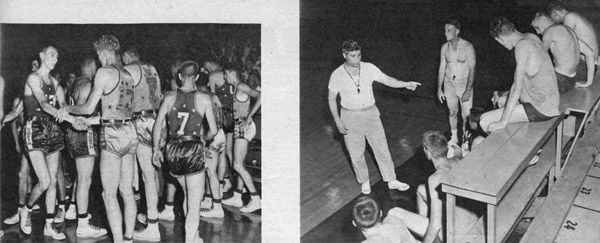 | (Left) After the game, won by the South, 86-75, with an effective fast break, the future college stars congratulate each other. (Right) Most of the practice sessions (all secret) were limited to talks, little work. Lack of time prevented much play-making. |
By using these shortcuts and by cutting corners in general, the commission has been able to operate in the black ever since the game started. Profits from $1,100 to $1,900 have been set aside from each game and placed in an operating fund.
One of the large and unavoidable expenditures is for transportation. This past year almost $1,500 was spent. It cost over $300 just to fly big Gary Nelson in from Elmo, Washington, last June. The commission decides how each player will travel to Kentucky - by plane, train or bus. Back in 1950, though, they were stumped by a youngster named Bill Hawken, an Indian who attended the School of the Osage, in Lake of the Ozarks, Missouri. Several letters were written to Hawken asking him how to send his ticket. They received only one answer, on a post card: "I'll be there in time to practice."
By the evening of the first day, all the boys except Hawkens had arrived. Near midnight, Bill finally showed up. He had hitched a ride all the way from his home to Murray in a minnow truck.
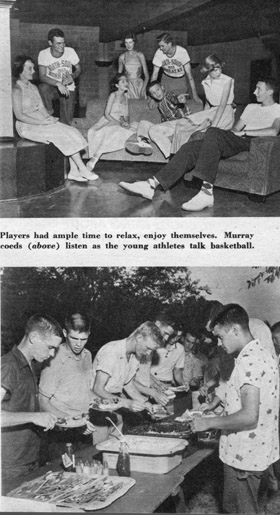 | Townsfolk entertained players with barbecues, picnics, fish fries, dances, tennis, golf and swimming parties. |
"You ought to put more pressure on the boys while they're here," one citizen told Hodges. "Why, the college doesn't even carry these kids on a tour of the campus or town while they're here, or put college annuals or bulletins in their rooms. They leave after the week knowing no more about Murray State College than when they arrived. All these other coaches who come here work overtime getting boys, and what are we doing ? Nothing! As long as we're spending the dough, we ought to get something out of it."
What he said represented not an uncommon argument. (Before the 1953 game, Murray attracted five players, one of them on the rebound. Of the group, only one, Howie Crittenden, is still at Murray.) The school was not getting as many players from the game as most other colleges. Why, then, all the hard work promoting it ?
The answer to the question came from Mayor George Hart of Murray, who is pretty much boss of the operation, and Roy Stewart, college athletic director. First, they explained, the game has enabled Murray State to obtain a major basketball schedule. With a constant flow of visiting college coaches, Murray has been able to build a 30-game schedule of bigtime competition that extends from St. Bonaventure and Siena in the East to Houston in the Southwest and Brigham Young in the Far West.
Then, the game has brought good publicity to Murray and the Kentucky Lake region, now fast becoming known as the "Playground of Mid-America." Many visitors to the game have returned to spend part of their vacation in one of the resorts surrounding TVA's vast Kentucky lake - and the tourist dollar means a great deal to Murray, a city of less than 8,000 population.
Interest in the basketball game that climaxes the frenzied week is always high, especially among the players. Practices are always secret. The squads are even housed in separate wings of the college dorm. All week the rivalry builds as the natural competitive argument of North vs. South is fully exploited. Typical is a writeup in last June's program on Ed Franklin, a schoolboy star from Houston, Texas.
"Some 117 years ago the Kentucky-Tennessee area sent sharp-shooting Sam Houston to the West to save Texas from the Mexicans. Texas is delighted to reciprocate by sending its Twentieth Century counterpart - Ed Franklin of Houston's Lamar High - to Murray to save the southern high school basketball stars from the damyankees . . ." Franklin didn't score any points, but the South won.
The Rebel national anthem. "Dixie," was outlawed for three seasons. Back in 1949, the first year of the series, the Southerners staged a second-half rally to win, 53-50. The organist had orders to alternate the playing of such airs as "Yankee Doodle Dandy" and "Dixie" during timeouts. A rabid Rebel contingent unfurled the stars and bars during the second half and the organist spent nearly 20 minutes making the Carr Health Building reverberate with the blazing strains of "Dixie." The South responded nobly and almost ran the Yankees into the hardwood floor. Several irate visitors from north of the Mason-Dixon line made it a point to tell Murray State president Ralph Woods they thought these tactics unfair. Consequently the only time "Dixie" was heard for three long years was just prior to the game.
This year the commission allowed ''Dixie" to be played again - and again the South won. In the three Dixieless years, victory went to the Northerners.
Basketball in Kentucky in June can be hot, even without "Dixie." But a home-made air-conditioning system keeps the gym cool for the games. On the morning of the game, Murray's fire department begins spraying down the roof of the gym and the surrounding terrain. This is'continued at intervals throughout the day and into the evening until two hours before the game. Large tubs of ice are placed under the bleachers and circulating fans blow the moist, cold air to all parts of the gym.
Even the weatherman has cooperated. In four of the five years, heavy rainstorms on the afternoons of the games relieved much of the 90-plus temperature.
Bringing boys from all sections of the country together and trying to fashion workable teams in a week's time is a tough task for the four coaches chosen for the game each year. But most of the players have been friendly and acclimate themselves quickly to the playing conditions and their teammates. Big Dean Parsons, now playing for Tippy Dye at Washington, felt left out when introductions of the North team were made in 1951. The loudspeaker called out Schuiz and Faridoni and Gastevich and Simonovich. "In order to make me fit, call me Parsonovich," Dean grinned as he laced up his size-17 shoes.
With all going well with the North-South game, there is one serious problem - the seating capacity of the Murray gym. Already three colleges with larger field houses have indicated they would like to take over the series if Murray has to drop it. Ever since the first game, the commission has announced that next year the game would be played in a larger and better fieldhouse. Until last June, that is. Then, all references to the gym were deliberately avoided. A proposed Murray fieldhouse is in the blueprint stage and it was hoped that it could be built for occupancy this winter. But Kentucky Governor Lawrence Weatherby refused an additional $50,000 appropriation needed to assure its completion. After attending the first four games to make the awards, the governor did not show up last June. "Embarrassed about the field house," many critics said. "We started to invite Happy Chandler, who is going to run for governor next year," one Commission member said, "but then some of the boys thought Weatherby might get sore and cut the appropriation even more."
No matter what else, Murray's great pride in the North-South game is the best reason why the town will protect the classic (as they all call it) from covetous eyes. In the meantime, townsfolk sit around and talk about the feats of Gola, Pettit, Palazzi and the other alumni. Tickets for the 1954 game go on sale soon and the mad scramble will be on again.
![]()
Return to Kentucky Basketball page, statistics, team schedules, team rosters, opponents, players, coaches, opposing coaches, games, assistance or search this site.
![]()